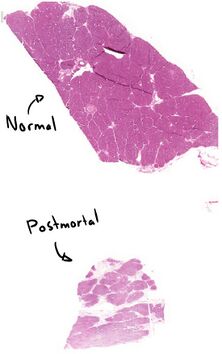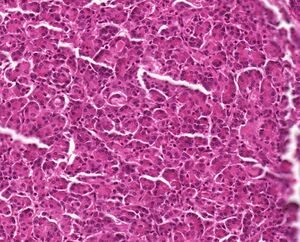1. Normal and postmortal pancreas: Difference between revisions
No edit summary |
No edit summary |
||
| Line 1: | Line 1: | ||
[[File:Postmortem pancreas overview.jpg|thumb|Overview| | [[File:Postmortem pancreas overview.jpg|thumb|Overview|354x354px]]'''Staining:''' HE . '''Organ:''' Pancreas | ||
'''Description:''' This slide shows the pancreas. A part of it is normal, while a part of it is pathological. The part shown on the picture is pathological. | '''Description:''' This slide shows the pancreas. A part of it is normal, while a part of it is pathological. The part shown on the picture is pathological. | ||
| Line 8: | Line 8: | ||
'''Theory:''' All these characteristics can also be found in acute pancreatitis as well. To differentiate between postmortal pancreas and acute pancreatitis, we must check to see if there is a vital reaction. The word “vital” in this case means “living”. The vital reaction is a reaction that would be present in a living person. When we talk about the vital reaction in this case, we mean the presence of neutrophils. In the case of an acute pancreatitis will the body recruit neutrophils to the inflammation, but the body obviously cannot recruit them there post-mortem. To summate: If there are neutrophils present, the slide is of an acute pancreatitis, if not, the slide is a postmortal pancreas. In this particular slide, there is no vital reaction. Note the lack of nuclei in the cells, and their increased eosinophilia.[[File:Normal pancreas.jpg|thumb|Normal pancreas. Everything looks normal. Anatomy department should’ve used this slide.|left]] | '''Theory:''' All these characteristics can also be found in acute pancreatitis as well. To differentiate between postmortal pancreas and acute pancreatitis, we must check to see if there is a vital reaction. The word “vital” in this case means “living”. The vital reaction is a reaction that would be present in a living person. When we talk about the vital reaction in this case, we mean the presence of neutrophils. In the case of an acute pancreatitis will the body recruit neutrophils to the inflammation, but the body obviously cannot recruit them there post-mortem. To summate: If there are neutrophils present, the slide is of an acute pancreatitis, if not, the slide is a postmortal pancreas. In this particular slide, there is no vital reaction. Note the lack of nuclei in the cells, and their increased eosinophilia.[[File:Normal pancreas.jpg|thumb|Normal pancreas. Everything looks normal. Anatomy department should’ve used this slide.|left]] | ||
[[File:Postmortem pancreas.jpg|thumb|Postmortal pancreas. Note the absence of nuclei, hypereosinophilia and loss of structure. Note that there are no neutrophils.]] | [[File:Postmortem pancreas.jpg|thumb|Postmortal pancreas. Note the absence of nuclei, hypereosinophilia and loss of structure. Note that there are no neutrophils.|285x285px]] | ||
[[Category:Pathology 1 - Histopathology slides]] | [[Category:Pathology 1 - Histopathology slides]] | ||
Latest revision as of 17:06, 11 July 2024

Staining: HE . Organ: Pancreas
Description: This slide shows the pancreas. A part of it is normal, while a part of it is pathological. The part shown on the picture is pathological.
A part of it is very pale and eosinophilic compared to the rest of the slide. Upon closer inspection you can see that the cells in this part also lack nuclei. The normal structure and arrangement of the cells is mostly lost, and the remaining cells are less organized.
Diagnosis: Normal and postmortal pancreas
Theory: All these characteristics can also be found in acute pancreatitis as well. To differentiate between postmortal pancreas and acute pancreatitis, we must check to see if there is a vital reaction. The word “vital” in this case means “living”. The vital reaction is a reaction that would be present in a living person. When we talk about the vital reaction in this case, we mean the presence of neutrophils. In the case of an acute pancreatitis will the body recruit neutrophils to the inflammation, but the body obviously cannot recruit them there post-mortem. To summate: If there are neutrophils present, the slide is of an acute pancreatitis, if not, the slide is a postmortal pancreas. In this particular slide, there is no vital reaction. Note the lack of nuclei in the cells, and their increased eosinophilia.


